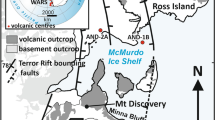Abstract.
Savo Island is the 6-km-diameter emergent summit of an andesitic-dacitic stratovolcano, rising from the Iron Bottom Sound, 35 km NW of Honiara, Solomon Islands. Savo has erupted at least three times within recorded history and the 3,000 inhabitants maintain extensive oral traditions of past events. Through description and interpretation of the volcaniclastic sequences on the island, in conjunction with historical accounts and oral traditions, we reconstruct the eruptive processes on Savo. Block-and-ash flow (BAF) deposits are volumetrically dominant on the island within three main depositional environments: near-vent sequences, thick medial channel sequences and distal fan sequences. The deposits comprise universally non-vesicular and highly porphyritic (40–70% phenocrysts), high-silica andesite and dacite clasts. These appear to have been derived from collapsing lava domes during an 1560–1570 A.D. eruption. However, eyewitness descriptions and crater morphology suggest that similar deposits formed from dome explosions or collapses of eruption columns during later eruptions (1830–1840 A.D.). The high-sodium magmas (ca. 5–7 wt% Na2O) apparently crystallised and strongly degassed prior to eruption. Shallow explosions were possibly caused by entrapment of magmatic gases beneath a dome or conduit plug of highly crystalline, near solid magma. Repeated sealing of the vent may have been due to inward collapse of the highly altered rocks of the surrounding hydrothermal system; these rocks probably were saturated due to contemporaneous high intensity rainfall events. BAFs were hot enough to char vegetation and attain aligned clast TRM (thermal remnant magnetism) up to 3 km from the vent, many being accompanied by ash-cloud surges. Changes with distance in the BAF deposits appear mostly dependent on flow confinement and are limited to an overall decrease in thickness and maximum clast size, and an increased definition of weak planar fabrics. In distal fan sequences, there is strong evidence for syn- and post-eruptive redeposition of primary deposits. Since the Savo population is concentrated on coastal volcaniclastic fans, we consider the greatest volcanic risk to life is from BAFs, associated ash-cloud surges and lahars. Hence, the main channels and fans are designated as the highest of three relative hazard zones on a simple map prepared to aid local education and planning initiatives on Savo.
Similar content being viewed by others
Author information
Authors and Affiliations
Additional information
Electronic Publication
Rights and permissions
About this article
Cite this article
Petterson, M., Cronin, S., Taylor, P. et al. The eruptive history and volcanic hazards of Savo, Solomon Islands. Bull Volcanol 65, 165–181 (2003). https://doi.org/10.1007/s00445-002-0251-0
Received:
Accepted:
Published:
Issue Date:
DOI: https://doi.org/10.1007/s00445-002-0251-0




